The Hammer
Simon de Pury on Why the Art Market Won’t Let the Lights Go Out
Following the news of Christie's cyberattack, the veteran auctioneer looks back on another a sweaty auction moment.
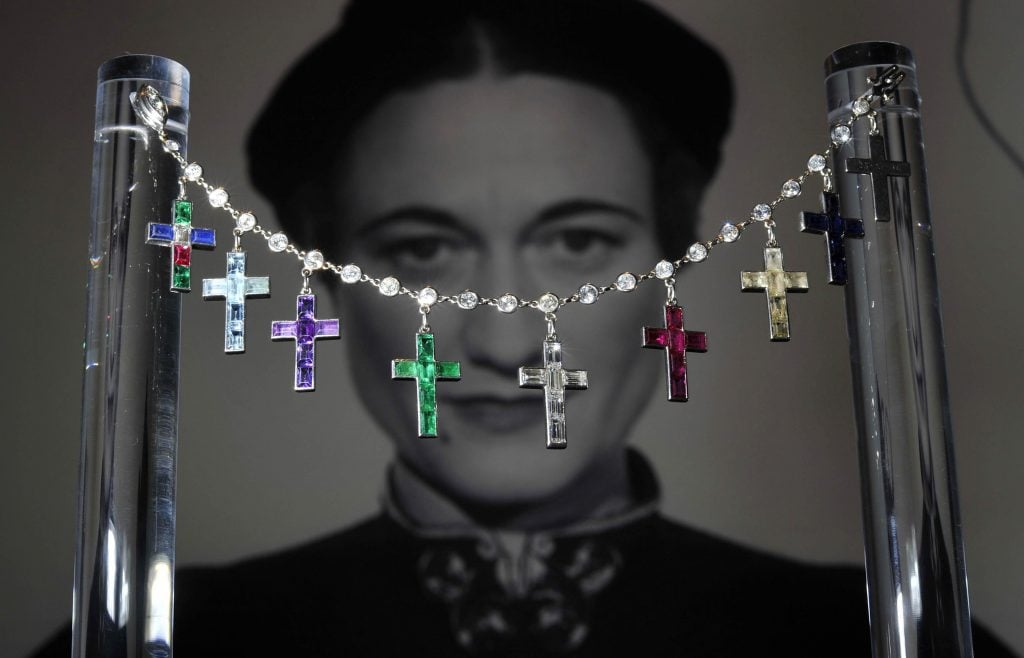
Following the news of Christie's cyberattack, the veteran auctioneer looks back on another a sweaty auction moment.

Simon de Pury

Every month in The Hammer, art-industry veteran Simon de Pury lifts the curtain on his life as the ultimate art-world insider, his brushes with celebrity, and his invaluable insight into the inner workings of the art market.
Cities, like humans, go through better times as well as sometimes through less good moments. They never stand still and like us constantly evolve. At the moment I often hear people complaining that New York is not what it used to be. First of all nothing is ever what it used to be in any case! Yet I have never arrived to this vibrant metropolis without feeling instantly energized the minute my feet hit the ground. This time was no exception!
I came to New York in early May to view the offerings of the three auction houses. While there weren’t any important estates or private collections this season, the auction previews are at all times the perfect opportunity to inspect or admire close up a vast selection of works of art by known and lesser-known artists.
A number of art world pundits had gleefully been predicting, if not quite a bloodbath of the market tanking, at least a very hard landing. None of it happened as Phillips, Sotheby’s and Christie’s did a great job in selling the vast majority of works on offer. One had to admit that for a market that had been declared dead, that there were remarkable signs of vitality in the corpse. While the change of taste is constantly evolving and accelerating, the interest and appetite for art is as strong as ever. This could also be witnessed at the opening of Tefaf at the Park Avenue Armory.
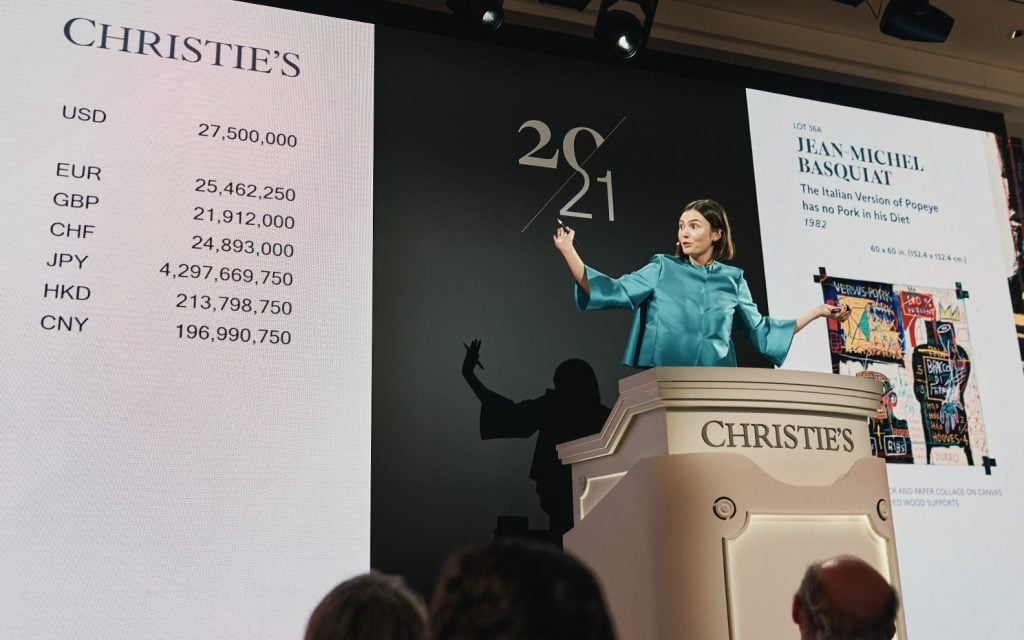
Christie’s auctioneer Georgina Hilton sells the top lot of the house’s 21st-century evening sale, Basquiat’s The Italian Version of Popeye has no Pork in his Diet, (1982) for $32 million. Courtesy of Christie’s.
The most serious challenge this season came from an unexpected source when the website of Christie’s crashed at the worst possible moment, as a result of a major cyberattack. Online bidding, which especially since the Covid pandemic, had become the prime method used by collectors to participate in auctions, was not going to be possible. None of the consignors panicked or demanded their works to be sold at a later date and none of the buyers held back as a result of them having to either bid by attending the sale in person or by bidding over the telephone, as they had done over decades prior to bidding online.
The big question everyone was asking was who could possibly be behind such an attack. On May 27, Artnet News reported that the attack had been made by the hacking group RansomHub, which was threatening to release sensitive client information. Two days later, an email sent by Christie’s to its clients said that only identification data had been stolen, but no financial or transaction data. Since the Christie’s hack happened, I am told that much stricter guidelines have been enforced at the three houses to make access to sensitive information more difficult for in-house specialists.
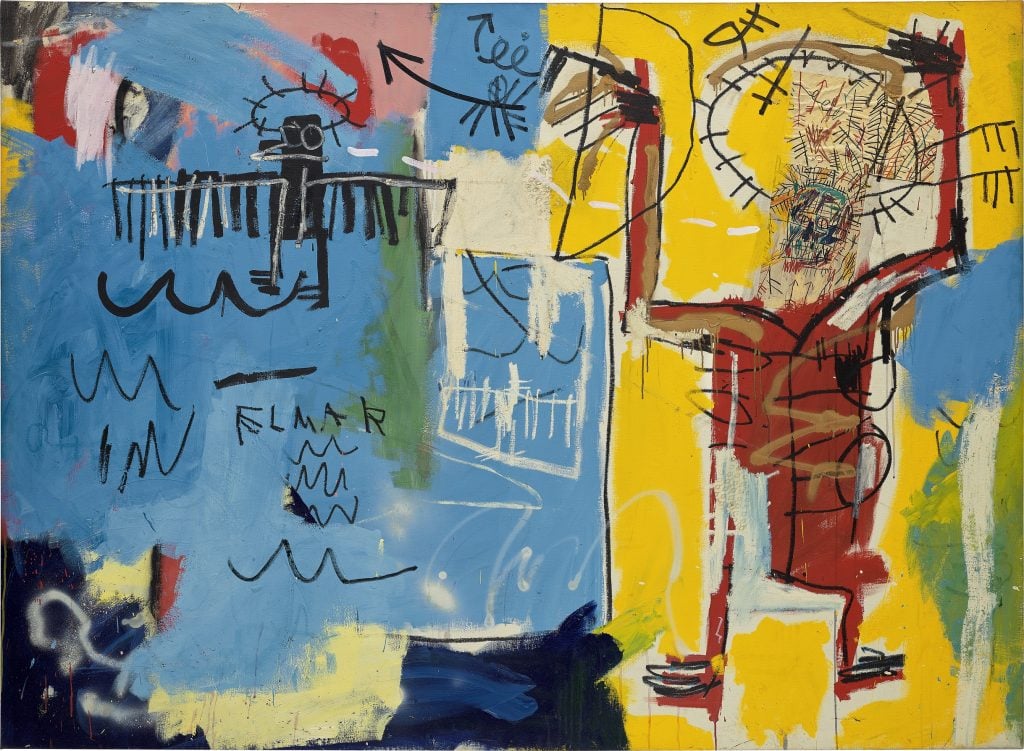
Jean-Michel Basquiat, Untitled (ELMAR), 1982. Courtesy of Phillips.
The auction business is fiercely competitive, even though it is dominated by the duopoly of Sotheby’s and Christie’s and by Phillips, which has been making major inroads breaking into it, by, for instance, selling this season’s most expensive painting, a work by Jean-Michel Basquiat for $46.5 million.
If ever there was any need for it, the hacking episode highlighted the extreme fragility of our way of conducting business. The art market, however, had already at times in the past to contend with unexpected challenges to its smooth working.
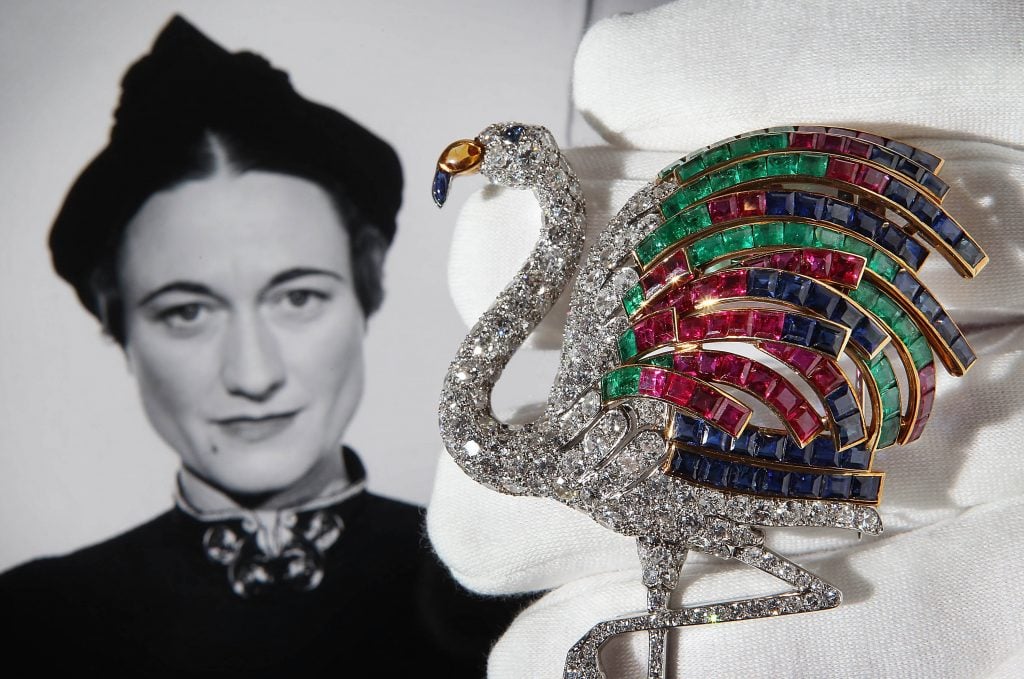
A Cartier flamingo diamond clip from 1940. part of the Jewels of the Duchess of Windsor collection. Photo by Peter Macdiarmid/Getty Images.
It reminded me in particular of an incident that had happened in 1987 at the time when Sotheby’s had succeeded in securing the most important jewelry auction ever to appear on the market: The Jewels of the Duchess of Windsor. It was a major coup for Sotheby’s in the eternal battle between the two big houses. The global interest by the media and the public at large was without precedent.
The auction catalogue became a collector’s item in its own right and preview exhibitions in London and New York had attracted record crowds that were queuing for hours around the block before being able to access them. I had just been made managing director for Sotheby’s Europe, and it was obvious that we were going towards a historical landmark sale in Geneva. No venue was big enough to accommodate the crowds that were expected to attend the auction. Exceptionally, the local authorities granted permission to build a massive tent on the shores of Lake Geneva.
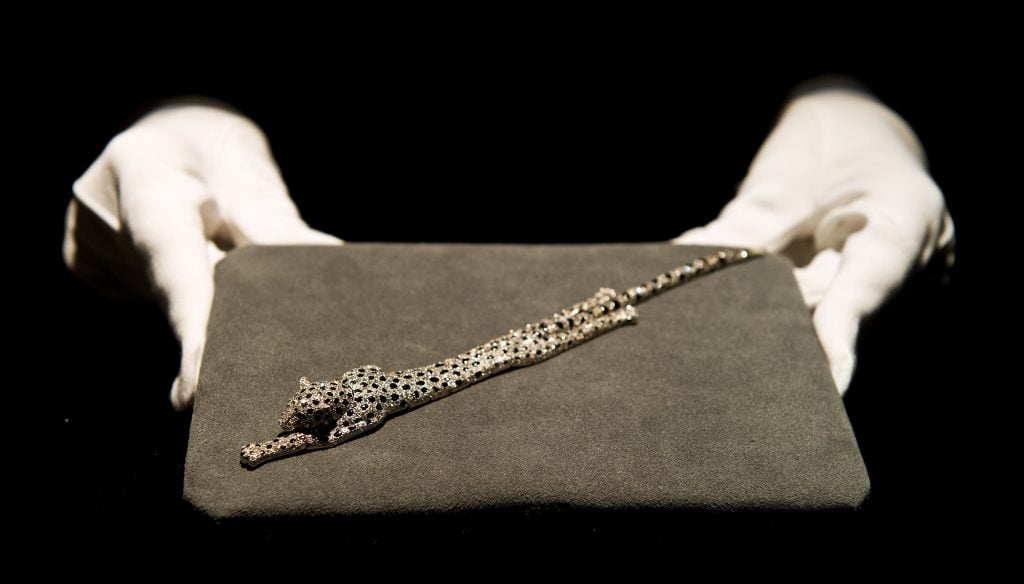
An onyx and diamond panther-shaped bracelet previously owned by the Duchess of Windsor. Photo: Leon Neal/AFP via Getty Images.
A huge number of temporary electric lines were being linked to the tent to handle the increased demand for current for lighting, microphones, and the more than 75 phone banks that were going to be occupied by the international representatives of Sotheby’s who would relay the seemingly unlimited bids coming over the phone into the sale room marquee. In one of the many preparatory logistics planning meetings, Michael Ainslie, the smart CEO of Sotheby’s, pointed out that the only thing that could possibly go wrong would be a power cut. He therefore demanded that a temporary power generator should be installed. It was no small undertaking to get one for the highly unlikely occurrence of a power cut.
The workmen who installed it informed me that should there really be one, the tent would go completely dark, but that within a few seconds, the lights would go back on thanks to the generator that would kick in. When Nicholas Rayner, the brilliant auctioneer who is to be credited for securing this prestigious collection, started the auction, it was like attending a pop concert. For every single lot it seemed like every single person in the room was raising their arms to bid. Needless to say that the phone banks were also in full action mode. It is over the phone that Elizabeth Taylor acquired the famous Prince of Wales feather brooch, while sitting next to her L.A. swimming pool.

Elizabeth Taylor introduces her new perfume, “Passion”, on April 7, 1987. Photo: Bettmann/ Getty Images.
After a triumphant start to the proceedings, circa fifteen minutes into the sale, all of a sudden the lights went out, and for a few seconds that seemed an eternity to me, the room was pitch dark. Then the power generator kicked in and none of the eager bidders were aware what had happened. I was purple, green, and gray and in a state of total shock. Record after record was broken after endless bidding fights and an auction that normally should have lasted ninety minutes was going to last several hours. I was thinking to myself “nobody realizes that soon the temporary generator will stop working and we will have an utter disaster on our hands!” I didn’t know that the temporary generator could easily work for hours and that there was no need to be concerned.
The whole event ended in euphoria and general elation in the early morning hours. When my colleagues and I eventually left the tent we saw that someone, in an act of sabotage, had used an axe to cut through all the electric lines. This is what had caused the ultra short power cut and had started the generator.
In a case like this the question is always who would be the prime beneficiary of such a sabotage. To this day it has never been established who had committed or instigated that criminal act. To this day I thank my lucky stars—and Michael Ainslie—for having had the foresight to plan for the worst case scenario.
Even in the microcosm of the art market we have to be constantly alert, and the danger usually comes from where you expect it the least!
Simon de Pury is the founder of de PURY, former chairman and chief auctioneer of Phillips de Pury & Company, former Europe chairman and chief auctioneer of Sotheby’s, and former curator of the Thyssen-Bornemisza Collection. He is an auctioneer, curator, private dealer, art advisor, photographer, and DJ. Instagram: @simondepury